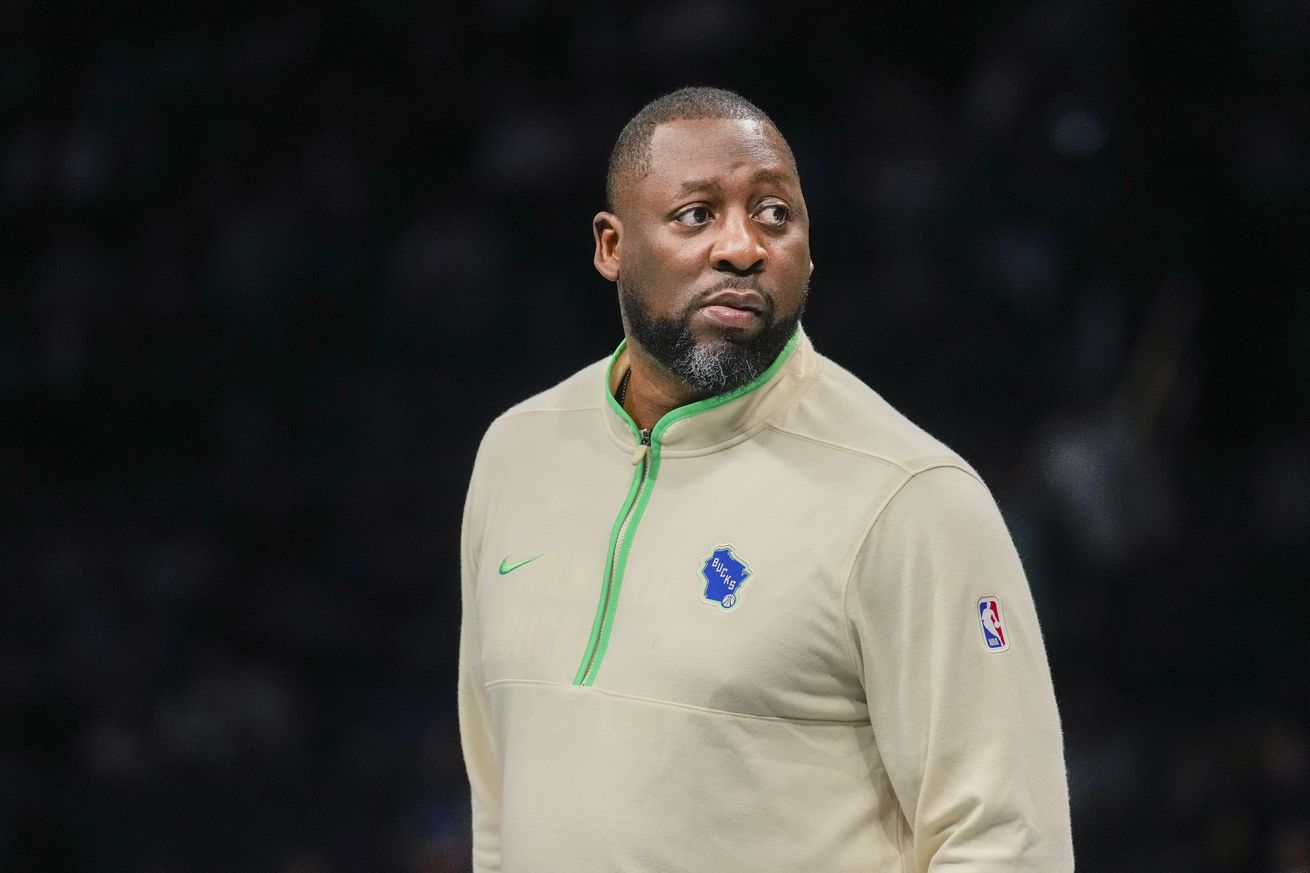
The Milwaukee Bucks have a top five record, but are they as good of a team so far this season?
Note: all stats and records are as of Monday, December 4.
Change is the only constant in life. For the Milwaukee Bucks, these past few months have brought down a whirlwind of change. A new coaching staff and a new superstar have led to a new way of doing things. Change is hard, often uncomfortable, and regularly frustrating. For a basketball team that has competed at a high level for several years, these changes were widely assumed to come with a hefty side dish of growing pains. Moreover, for a basketball team with a demonstrated history of success, the necessity of such changes was openly questioned.
And as you might expect, it’s been a bumpy ride since the opening tip! As early as the preseason, we saw several stretches of play where the Bucks looked out of sorts and out of position, particularly on the defensive side of the ball. Opposing teams routinely worked the ball into uncontested dunks or open threes, forcing Milwaukee to lean on the offensive acumen of Giannis Antetokounmpo, newcomer Damian Lillard, and (part of the time) Khris Middleton to make up for the deficits. It got bad enough that the players held what ESPN’s Zach Lowe described as “a polite mutiny” after the first handful of games, resulting in head coach Adrian Griffin dialing back the defense’s aggressiveness and returning center Brook Lopez to his patrol of the paint. This reversal helped but the team is still prone to defensive lapses that keep games too close for comfort on a consistent basis.
But the more things change, the more things stay the same. Historically, the Milwaukee Bucks are a perennial leader in the standings…and today sit at 14-6, good for third in the Eastern Conference and only 1.5 games back of the leading Boston Celtics. Since Giannis realized the full extent of his basketball powers, Milwaukee routinely stifled opponents on defense… and performance has taken a hit on that side, truth be told. While Milwaukee’s D has suffered from the significant shifts (115.1 DRtg, 21st overall on the season), the Bucks’ defensive rating has improved to 13th overall (114.2 DRtg) in the last 10 games and continues to trend in the right direction. It’s getting better! And no matter what, the Bucks’ coaching comes under fire… while the team still ranks in the “True Contender” tier with national pundits despite their hire being “on track to go down as the biggest mistake any team has made this offseason.” Truthfully, this is pretty over the top, but some things never change.
Let’s talk about Adrian Griffin for a moment, and step back to better view the job he took as compared to the job he has. Coach Griff was hired on June 5 of this year, and like any new coach had to hit the ground running to build his staff and prepare for training camp while the front office simultaneously navigated the NBA Draft, free agency, and any other changes the offseason might bring. During the month of June, there were two major areas of ambiguity that would need to be accounted for:
- Giannis Antetokounmpo and Khris Middleton each underwent a surgical procedure in the offseason, and would not be completely ready to go at the beginning of camp. Obviously, Giannis was widely expected to return in short order, but Khris’ availability has been a running question for some time, meaning the core part of the rotation was in flux.
- Brook Lopez was a free agent and while the Bucks ended up retaining his services, it later came out that he nearly left town for an offer presented by the Houston Rockets. This means the Bucks spent most of June and the first crucial days of July not knowing if their defensive lynchpin would remain.
Regardless of what system Griffin wanted to install or what other players might be brought in, an offseason where three of the core four players on the roster had significant uncertainty around them creates a difficult environment to strategize within. After most of the offseason was over with, Coach Griff knew he could rely on Jrue Holiday, the Bucks’ All-Defensive First Team guard who is also one of the best point-of-attack perimeter defenders in recent NBA history.
Well, at least on September 27. But on September 28…
So for whatever critiques lobbed his way, Adrian Griffin has unwittingly thrown himself into a baptism by fire. A rookie head coach is likely challenging enough with the expected roster churn from year to year (pre-trade, Milwaukee already welcomed five new players into the fold); Griffin also had to contend with his superstar player recovering from surgery, another core player also recovering from surgery, a third core player legitimately considering a change of scenery, and a fourth core player exchanged for Damian freakin’ Lillard… and all within the first four months on the job. That’s tough.
Even still, while considering the factors outside of his control, many of the criticisms leveled at Coach Griff are based on decisions made within his control, particularly on the defensive side. It’s one thing to install a new scheme when the old one worked just fine, thank you. It’s another to install a new scheme that fits so poorly with the core of the roster that you can count on one hand the number of games that go by before a major adjustment is thankfully deployed. That, when coupled with predictable (and understandable) struggles that come with a first-timer—the questionable rotations, playing lineups with too many poor defenders, the discretion of which calls to challenge—and the whole Terry Stotts thing? Patient or not, that’s a lot of bad vibes from an important part of the franchise when the stakes are at their absolute highest.
Like it or not, that’s the root cause of the consternation surrounding Adrian Griffin since the season’s beginning. The Milwaukee Bucks are contenders now, and any blunders (perceived or otherwise) from the head coach that undermine the team’s chances at another title have a magnified impact. Griffin, through no fault of his own beyond saying “yes” to the Bucks’ offer of employment, inherited a team (and fanbase) that had gotten used to high levels of sustained success; any deviation from that trajectory would be heavily scrutinized. Anything else cannot be afforded, not now.
And deviations have happened… but the tenor of conversations about the team (depending on your environment of choice, at least) is ambivalent. The Milwaukee Bucks have struggled mightily… as long as you ignore the scoreboard. The Milwaukee Bucks are in trouble… as long as you overlook the standings! The Milwaukee Bucks can’t beat the good teams… except, they do! How can there be so much disparity between reputation and reality? What cognitive dissonance is at play with large swathes of the fanbase to cause such a ruckus?
As with most things in life, the truth is somewhere in between the two extremes. Yes, the Bucks have struggled relative to their recent standards. And yes, the Bucks are still scoring points, still getting stops, and still winning games. It doesn’t look the same way it used to and that might just be how things are now. A new normal.
First, let’s look at the Bucks’ history. Longtime Brew Hoopers might recall my Mantra, Quantified piece from December 2021 that looked at Milwaukee’s performance quarter-by-quarter over the course of the Mike Budenholzer era. The premise of that post was focused on point differential at the end of every playing period (quarters one through four and each overtime) as a means of analyzing just how well the Bucks were achieving the goal of “getting better, every day.”
Separating the efforts of coaches and the efforts of players is a fool’s errand. One is on the court and the other is not, yet the results belong to both. So when considering the Bucks, who boast a fine collection of talent on the roster, it would be both easy and accurate to simply compare Milwaukee’s players to whoever their opponent might be and conclude that Milwaukee is, more often than not, simply better. Therein lies the difficulty (futility?) with attempting to draw a clear line between process (which coaches control and players influence) and results (vice versa), especially when all of the numbers available publicly are focused on results. I know ”results” is what the Bucks care about most, but “process” matters.
[…] “Basketball is a game of runs.” It’s a common phrase that’s been used often enough to be treated as fact, even though there is some research that suggests it’s not quite so. In any case, a short-term run is not enough to go off of, and the variability of runs (both in terms of frequency and length) makes them too nebulous a measure. However, there is one division that applies evenly to all teams but is still small enough to generate a large enough data set: quarters.
To provide more context, I not only updated my data to include the entirety of Coach Bud’s tenure as head coach, but I added the first 20 games of Coach Griff’s season as well as the seasons led by previous head coaches Jason Kidd and Larry Drew. Yes, this data goes all the way back to 2013, the beginning of Giannis and Khris’ time as Bucks. Let’s take a walk down memory lane together and see just how far this team has come.
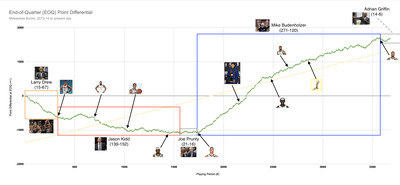
For guidance, the green line that looks like a stock price is the cumulative period-end quarter differential for the team since Game 1 of the 2013–14 season. For instance, if the Bucks won a game 100-96, and each quarter was a 25-24 advantage Milwaukee’s way, that game is represented with four consecutive data points of +1. After you stack the numbers up over the course of a few hundred games, you can see some long-term trends beyond just wins and losses. The cream-colored line is the general trend line, showing just how much more success the Bucks found in the last five years when compared to the five years that preceded the Bud Era. Each coach’s tenure is represented by a box around the green line, along with their record, and some notable players and events are indicated with the arrows. Here are some of my own takeaways:
Larry Drew: Built To Tank
Poor Larry Drew. Not only was he done dirty by the new owners when Jason Kidd was hired before he even knew he was out of a job, but while taking over with Rookie Giannis and Sophomore Khris, the bulk of the talent on the roster just wasn’t able to find success. His lone season as head coach was the franchise’s worst, but at least they managed to snag the 2nd overall pick in the following draft. There just weren’t any other high points during this season when Milwaukee was consistently overmatched; I don’t know which image is sadder, the single-season EOQ point differential graph (A) or Basketball-Reference’s bar chart summary (B).
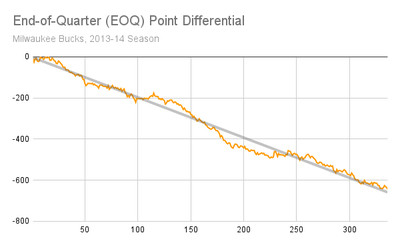

Jason Kidd: Things Got Better, Then Way Worse
Without lingering too long on the Kidd Era, it’s fair to say that his first year was a surprising turnaround that led Milwaukee back to the playoffs and a shred of respectability… that they immediately lost the next year. Jabari Parker’s various injuries, the evaporation of veteran talent after the initial success, and Greg Monroe’s place at the tail end of the post-centric offensive era all combined to put some fire beneath Kidd’s coaching chair… and his handling of player relationships did nothing but fan the flames. Giannis and Khris started coming into their own under Kidd, but the growth of their talent couldn’t overcome the burden of… everything else. Then again, they made the playoffs three out of four years, so it couldn’t have been that bad (it was). Also, Joe Prunty deserves a tip of the cap for managing a winning record during his time as interim coach; glad to have you back, Joe!
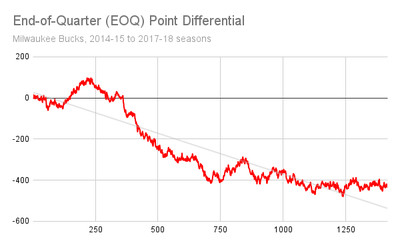
Mike Budenholzer: A Golden Era… Mostly
We know how much things turned around when Coach Bud took over; it’s no surprise that his steady control over the team’s strategy, embracing the NBA’s evolution of spacing the floor while protecting the paint, and Giannis’ breakthrough as an actual MVP-level player resulted in a playoff berth becoming the norm rather than an aspirational goal. We also know how that steady approach to coaching led to stagnation at the worst possible times, several times. Certain instances were perhaps less Budenholzer’s “fault” than others (the 2020 Bubble, Giannis’ back injury against Miami in 2023) but it’s hard to separate those exceptions from the other times (the 2019 Eastern Conference Finals against Toronto, and arguably the 2022 Conference Semis against Boston) where things went wrong, or even the one year when things actually worked out (the 2021 Conference Semis against Brooklyn). As I wrote back in 2021:
Most successful teams will have a similar trend line, but the Bucks have been one of the most successful teams ever over the past three years. Milwaukee in the Bud Era is a blue-chip stock gaining value steadily, and it’s largely due to the mantra of getting better, every day.
But just like in the stock market, you don’t actually improve endlessly. There are downs paired with the ups, and in basketball the timing of a dip can be absolutely devastating.
Bud’s teams dipped at the worst possible time, too many times. Ultimately, that’s why a coach with a championship and a historically high winning percentage was dismissed after five years in the lead chair; when your window to contend is open, you gotta make the most of it.
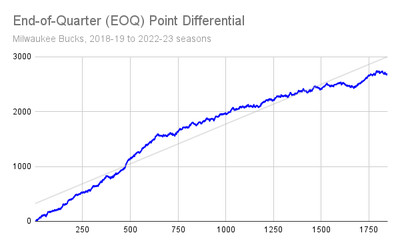
Adrian Griffin: Navigating The Learning Curve
We arrive now at the present day, only 20 games into Coach Griff’s tenure. Having reached the highs that the Bucks reached in the last five years, the risk of falling from that lofty perch presented by a rookie head coach made many fans nervous. That concern was almost immediately validated as the team routinely fell behind their opponents, even if they managed to mount a comeback. And while there still is a fair amount of ups and downs to the Bucks’ performance… their EOQ chart paints a positive picture. It’s possible that maybe, just maybe, those early struggles really were a part of simply “figuring it out.”
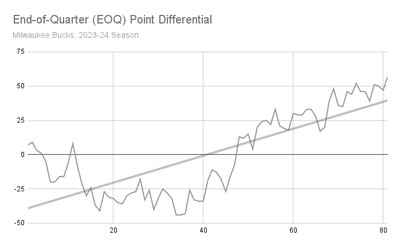
There’s a story hidden between those peaks and valleys. When the line goes down, it’s because the team lacks focus, is executing poorly, and isn’t set up for success. When the line goes up, it’s because they’re locked in, stringing together solid possessions, and grinding it out towards victory. And while there are tons of rises and falls in the graph, the overall trend is a positive one; the Bucks are finding themselves making more gains than losses. Should Milwaukee continue on this trajectory, they will get closer to the level of (regular season) excellence we’ve become accustomed to while also being better suited to adapt to the harsh environment of the NBA Playoffs. That is a win-win proposition if I’ve ever heard one.
And all the while, Adrian Griffin is learning on the job. He might play a weird lineup, make an odd substitution, or miss an obvious (to us) timeout opportunity, coach’s challenge, or situation to demand an intentional foul. All coaches do. But there are positives too, if you know where to look. Admittedly, these observations come from other viewers, folks with more experience and a better eye for dissecting coaching than I have, but now that I’ve learned I’m paying a different kind of attention to Coach Griff. For example, a head coach’s bench demeanor with players, staff, and officials is a “game within the game” that Griffin seems to play well. The offense is not just buoyed by two NBA Top 75 talents, but involves more movement than in years past, which reduces predictability and puts the defense in tough situations. The defense is more aggressive as a whole but vacillates between cautious (when older, slower players are active) and adventurous (when younger, more athletic players are on the court). The roster may not support the latter approach right now, but changes are always possible.
Most importantly, Coach Griff is listening to his players. The on-court performance might suffer, but the team is proving that they can turn it around more often than not. He’s open-minded, flexible, and humble enough to admit when he’s wrong. Griffin’s hire may yet be a sign of giving players (specifically Giannis, the most important person to the whole franchise) what they want rather than what they need, but what if he can thread the needle and do both?
The Bucks seem to think so. National media figures certainly don’t. Fans, as always, seem to be split. But no matter what, we are learning something from every contest; every game helps us separate what we know from what we thought we knew.